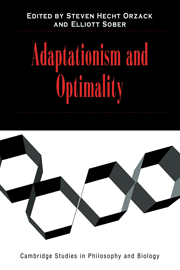Book contents
- Frontmatter
- Contents
- Contributors
- Acknowledgments
- Introduction
- 1 A Likelihood Framework for the Phylogenetic Analysis of Adaptation
- 2 Adaptation, Phylogenetic Inertia, and the Method of Controlled Comparisons
- 3 Optimality and Phylogeny: A Critique of Current Thought
- 4 Fit of Form and Function, Diversity of Life, and Procession of Life as an Evolutionary Game
- 5 Optimality and Evolutionary Stability under Short-Term and Long-Term Selection
- 6 Selective Regime and Fig Wasp Sex Ratios: Toward Sorting Rigor from Pseudo-Rigor in Tests of Adaptation
- 7 Is Optimality Over the Hill? The Fitness Landscapes of Idealized Organisms
- 8 Adaptation, Optimality, and the Meaning of Phenotypic Variation in Natural Populations
- 9 Adaptationism, Optimality Models, and Tests of Adaptive Scenarios
- 10 Adaptation and Development: On the Lack of Common Ground
- 11 Three Kinds of Adaptationism
- 12 Adaptation, Adaptationism, and Optimality
- Index
5 - Optimality and Evolutionary Stability under Short-Term and Long-Term Selection
Published online by Cambridge University Press: 06 January 2010
- Frontmatter
- Contents
- Contributors
- Acknowledgments
- Introduction
- 1 A Likelihood Framework for the Phylogenetic Analysis of Adaptation
- 2 Adaptation, Phylogenetic Inertia, and the Method of Controlled Comparisons
- 3 Optimality and Phylogeny: A Critique of Current Thought
- 4 Fit of Form and Function, Diversity of Life, and Procession of Life as an Evolutionary Game
- 5 Optimality and Evolutionary Stability under Short-Term and Long-Term Selection
- 6 Selective Regime and Fig Wasp Sex Ratios: Toward Sorting Rigor from Pseudo-Rigor in Tests of Adaptation
- 7 Is Optimality Over the Hill? The Fitness Landscapes of Idealized Organisms
- 8 Adaptation, Optimality, and the Meaning of Phenotypic Variation in Natural Populations
- 9 Adaptationism, Optimality Models, and Tests of Adaptive Scenarios
- 10 Adaptation and Development: On the Lack of Common Ground
- 11 Three Kinds of Adaptationism
- 12 Adaptation, Adaptationism, and Optimality
- Index
Summary
The theory of long-term selection was originally suggested as a means of closing the gap between the phenotypic and the genotypic approaches to natural selection (Eshel and Feldman 1984; Eshel 1991; see also Eshel 1996; Hammerstein 1996; Matessi and Di Pasquale 1996). The objective was to incorporate aspects of the dynamical theory of selection on genotypes, sometimes called the population genetic approach to evolution, into the population game theory of evolution, which is widely used in ecology, especially behavioral ecology. The latter theory usually seeks some specific value of the behavior under study, a value that can be regarded as optimal with respect to some array of alternatives. For this reason, the gametheoretic or phenotypic approaches are subsumed under the title “optimality models.” They generally involve implicit assumptions about the genotypic basis for the phenotypic variation, assumptions that are often regarded as unrealistic by population geneticists. In this chapter we discuss these two approaches and explain how they are related. In particular, we are interested in the genetic conditions under which the results of optimality models coincide with those of explicit population genetic models.
We start by distinguishing two sorts of population dynamics. Each one is characteristic of the process of biological evolution, but each is appropriate for a different time scale.
We call short-term evolution the dynamics of the relative frequencies of a finite, fixed set of genotypes, usually those that exist in the population at a given time but that may also include mutation from among a finite set of alleles. Short-term evolution proceeds by changes in the frequencies of genotypes represented in the population.
- Type
- Chapter
- Information
- Adaptationism and Optimality , pp. 161 - 190Publisher: Cambridge University PressPrint publication year: 2001
- 20
- Cited by



